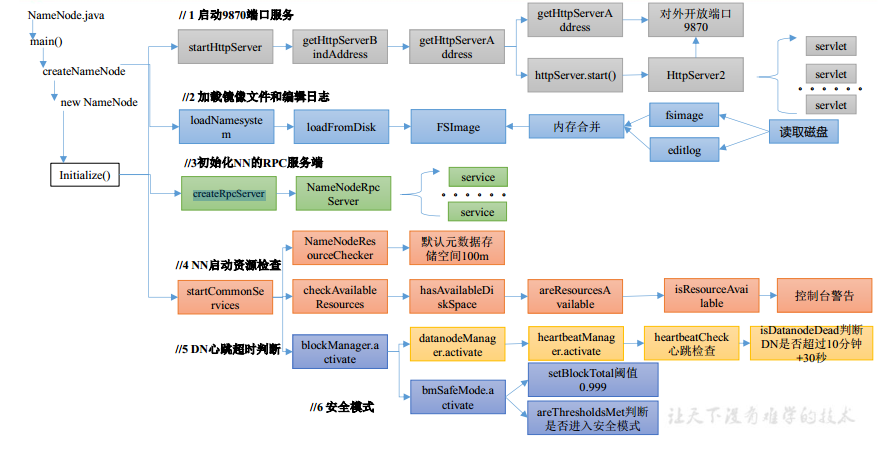9.5 KiB
9.5 KiB
简介
本章详细介绍NameNode启动过程。主要是代码级别的解释。
nameNode的启动主要是有NameNode.java主导的,由main函数开始了解。
下面是main函数里面的主要内容,可以看到主要由createNameNode实现NameNode的启动。
NameNode namenode = createNameNode(argv, null);
if (namenode != null) {
namenode.join();
}
在createNameNode函数里面主要是分为两部分:
- 参数解析:主要关心解析startOpt,startOpt可以控制具体操作,比如format、rockback等。主要操作如下,后续会详细介绍。
模型情况下会走到启动的启动的流程里面。FORMAT ("-format"), CLUSTERID ("-clusterid"), GENCLUSTERID ("-genclusterid"), REGULAR ("-regular"), BACKUP ("-backup"), CHECKPOINT("-checkpoint"), UPGRADE ("-upgrade"), ROLLBACK("-rollback"), ROLLINGUPGRADE("-rollingUpgrade"), IMPORT ("-importCheckpoint"), BOOTSTRAPSTANDBY("-bootstrapStandby"), INITIALIZESHAREDEDITS("-initializeSharedEdits"), RECOVER ("-recover"), FORCE("-force"), NONINTERACTIVE("-nonInteractive"), SKIPSHAREDEDITSCHECK("-skipSharedEditsCheck"), RENAMERESERVED("-renameReserved"), METADATAVERSION("-metadataVersion"), UPGRADEONLY("-upgradeOnly"), HOTSWAP("-hotswap"), OBSERVER("-observer"); - 启动NameNode或者其他操作,比如format等。
启动
NameNode的核心主要在NameNode的构造函数里面。
this.haEnabled = HAUtil.isHAEnabled(conf, nsId);
// 检查HA的状态,主要是判断当前启动的是主实例还是备实例
state = createHAState(getStartupOption(conf));
this.allowStaleStandbyReads = HAUtil.shouldAllowStandbyReads(conf);
this.haContext = createHAContext();
try {
initializeGenericKeys(conf, nsId, namenodeId);
// 启动NameNode
initialize(getConf());
state.prepareToEnterState(haContext);
try {
haContext.writeLock();
state.enterState(haContext);
} finally {
haContext.writeUnlock();
}
} catch (IOException e) {
this.stopAtException(e);
throw e;
} catch (HadoopIllegalArgumentException e) {
this.stopAtException(e);
throw e;
}
initialize函数详解如下:
protected void initialize(Configuration conf) throws IOException {
// .... 省略
//登录kerberos
UserGroupInformation.setConfiguration(conf);
loginAsNameNodeUser(conf);
// 初始化监控信息
NameNode.initMetrics(conf, this.getRole());
StartupProgressMetrics.register(startupProgress);
pauseMonitor = new JvmPauseMonitor();
pauseMonitor.init(conf);
pauseMonitor.start();
metrics.getJvmMetrics().setPauseMonitor(pauseMonitor);
// .... 省略
if (NamenodeRole.NAMENODE == role) {
// 启动HTTPServer,会调用NameNodeHttpServer中的start函数,是基于org.eclipse.jetty.server.Server实现的
startHttpServer(conf);
}
// 从本地加载FSImage,并且与Editlog合并产生新的FSImage
loadNamesystem(conf);
//TODO 待确认用途
startAliasMapServerIfNecessary(conf);
//创建rpcserver,封装了NameNodeRpcServer、ClientRPCServer
//支持ClientNameNodeProtocol、DataNodeProtocolPB等协议
rpcServer = createRpcServer(conf);
initReconfigurableBackoffKey();
// .... 省略
if (NamenodeRole.NAMENODE == role) {
httpServer.setNameNodeAddress(getNameNodeAddress());
httpServer.setFSImage(getFSImage());
if (levelDBAliasMapServer != null) {
httpServer.setAliasMap(levelDBAliasMapServer.getAliasMap());
}
}
//启动执行多个重要的工作线程
startCommonServices(conf);
startMetricsLogger(conf);
}
startCommonServices函数详解
启动NameNode关键服务
private void startCommonServices(Configuration conf) throws IOException {
// 创建NameNodeResourceChecker、激活BlockManager等
namesystem.startCommonServices(conf, haContext);
registerNNSMXBean();
if (NamenodeRole.NAMENODE != role) {
startHttpServer(conf);
httpServer.setNameNodeAddress(getNameNodeAddress());
httpServer.setFSImage(getFSImage());
if (levelDBAliasMapServer != null) {
httpServer.setAliasMap(levelDBAliasMapServer.getAliasMap());
}
}
// 启动rpc服务
rpcServer.start();
try {
// 获取启动插件列表
plugins = conf.getInstances(DFS_NAMENODE_PLUGINS_KEY,
ServicePlugin.class);
} catch (RuntimeException e) {
String pluginsValue = conf.get(DFS_NAMENODE_PLUGINS_KEY);
LOG.error("Unable to load NameNode plugins. Specified list of plugins: " +
pluginsValue, e);
throw e;
}
// 启动所有插件
for (ServicePlugin p: plugins) {
try {
// 调用插件的start接口,需要插件自己实现,需要实现接口ServicePlugin
p.start(this);
} catch (Throwable t) {
LOG.warn("ServicePlugin " + p + " could not be started", t);
}
}
}
namesystem.startCommonServices
在当前函数中启动blockManager和NameNodeResourceChecker,blockManager比较关键。
void startCommonServices(Configuration conf, HAContext haContext) throws IOException {
this.registerMBean(); // register the MBean for the FSNamesystemState
writeLock();
this.haContext = haContext;
try {
//创建NameNodeResourceChecker,并立即检查一次
nnResourceChecker = new NameNodeResourceChecker(conf);
checkAvailableResources();
assert !blockManager.isPopulatingReplQueues();
StartupProgress prog = NameNode.getStartupProgress();
prog.beginPhase(Phase.SAFEMODE);
//获取已完成的数据块总量
long completeBlocksTotal = getCompleteBlocksTotal();
prog.setTotal(Phase.SAFEMODE, STEP_AWAITING_REPORTED_BLOCKS,
completeBlocksTotal);
// 激活blockManager,blockManager负责管理文件系统中文件的物理块与实际存储位置的映射关系,
// 是NameNode的核心功能之一。
blockManager.activate(conf, completeBlocksTotal);
} finally {
writeUnlock("startCommonServices");
}
registerMXBean();
DefaultMetricsSystem.instance().register(this);
if (inodeAttributeProvider != null) {
inodeAttributeProvider.start();
dir.setINodeAttributeProvider(inodeAttributeProvider);
}
// 注册快照管理器
snapshotManager.registerMXBean();
InetSocketAddress serviceAddress = NameNode.getServiceAddress(conf, true);
this.nameNodeHostName = (serviceAddress != null) ? serviceAddress.getHostName() : "";
}
blockManager.activate
启动blockManager.activate 主要是初始化blockManager。
主要包含下面几个方面:
- pendingReconstruction
- datanodeManager
- bmSafeMode
public void activate(Configuration conf, long blockTotal) {
pendingReconstruction.start();
// 初始化datanodeManager
datanodeManager.activate(conf);
this.redundancyThread.setName("RedundancyMonitor");
this.redundancyThread.start();
this.markedDeleteBlockScrubberThread.setName("MarkedDeleteBlockScrubberThread");
this.markedDeleteBlockScrubberThread.start();
this.blockReportThread.start();
mxBeanName = MBeans.register("NameNode", "BlockStats", this);
bmSafeMode.activate(blockTotal);
}
datanodeManager.activate
datanodeManager 启动。
void activate(final Configuration conf) {
datanodeAdminManager.activate(conf);
// beartbeat 启动。
heartbeatManager.activate();
}
datanodeAdminManager.activate
void activate(Configuration conf) {
final int intervalSecs = (int) conf.getTimeDuration(
DFSConfigKeys.DFS_NAMENODE_DECOMMISSION_INTERVAL_KEY,
DFSConfigKeys.DFS_NAMENODE_DECOMMISSION_INTERVAL_DEFAULT,
TimeUnit.SECONDS);
checkArgument(intervalSecs >= 0, "Cannot set a negative " +
"value for " + DFSConfigKeys.DFS_NAMENODE_DECOMMISSION_INTERVAL_KEY);
int blocksPerInterval = conf.getInt(
DFSConfigKeys.DFS_NAMENODE_DECOMMISSION_BLOCKS_PER_INTERVAL_KEY,
DFSConfigKeys.DFS_NAMENODE_DECOMMISSION_BLOCKS_PER_INTERVAL_DEFAULT);
final String deprecatedKey = "dfs.namenode.decommission.nodes.per.interval";
final String strNodes = conf.get(deprecatedKey);
if (strNodes != null) {
LOG.warn("Deprecated configuration key {} will be ignored.", deprecatedKey);
LOG.warn("Please update your configuration to use {} instead.",
DFSConfigKeys.DFS_NAMENODE_DECOMMISSION_BLOCKS_PER_INTERVAL_KEY);
}
checkArgument(blocksPerInterval > 0,
"Must set a positive value for "
+ DFSConfigKeys.DFS_NAMENODE_DECOMMISSION_BLOCKS_PER_INTERVAL_KEY);
final int maxConcurrentTrackedNodes = conf.getInt(
DFSConfigKeys.DFS_NAMENODE_DECOMMISSION_MAX_CONCURRENT_TRACKED_NODES,
DFSConfigKeys
.DFS_NAMENODE_DECOMMISSION_MAX_CONCURRENT_TRACKED_NODES_DEFAULT);
checkArgument(maxConcurrentTrackedNodes >= 0, "Cannot set a negative " +
"value for "
+ DFSConfigKeys.DFS_NAMENODE_DECOMMISSION_MAX_CONCURRENT_TRACKED_NODES);
Class cls = null;
try {
cls = conf.getClass(
DFSConfigKeys.DFS_NAMENODE_DECOMMISSION_MONITOR_CLASS,
DatanodeAdminDefaultMonitor.class);
monitor =
(DatanodeAdminMonitorInterface)ReflectionUtils.newInstance(cls, conf);
monitor.setBlockManager(blockManager);
monitor.setNameSystem(namesystem);
monitor.setDatanodeAdminManager(this);
} catch (Exception e) {
throw new RuntimeException("Unable to create the Decommission monitor " +
"from "+cls, e);
}
executor.scheduleWithFixedDelay(monitor, intervalSecs, intervalSecs,
TimeUnit.SECONDS);
}
详细参见:
